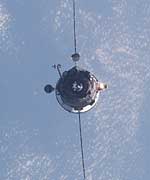An international team of astronomers have accurately determined the radius and mass of the smallest core-burning star known until now.
The observations were performed in March 2004 with the FLAMES multi-fibre spectrograph on the 8.2-m VLT Kueyen telescope at the ESO Paranal Observatory (Chile). They are part of a large programme aimed at measuring accurate radial velocities for sixty stars for which a temporary brightness “dip” has been detected during the OGLE survey.
The astronomers find that the dip seen in the light curve of the star known as OGLE-TR-122 is caused by a very small stellar companion, eclipsing this solar-like star once every 7.3 days.
This companion is 96 times heavier than planet Jupiter but only 16% larger. It is the first time that direct observations demonstrate that stars less massive than 1/10th of the solar mass are of nearly the same size as giant planets. This fact will obviously have to be taken into account during the current search for transiting exoplanets.
In addition, the observations with the Very Large Telescope have led to the discovery of seven new eclipsing binaries, that harbour stars with masses below one-third the mass of the Sun, a real bonanza for the astronomers.
The OGLE Survey
When a planet happens to pass in front of its parent star (as seen from the Earth), it blocks a small fraction of the star’s light from our view [1].
These “planetary transits” are of great interest as they allow astronomers to measure in a unique way the mass and the radius of exoplanets. Several surveys are therefore underway which attempt to find these faint signatures of other worlds.
One of these programmes is the OGLE survey which was originally devised to detect microlensing events by monitoring the brightness of a very large number of stars over extended time intervals. During the past years, it has also included a search for periodic, very shallow “dips” in the brightness of stars, caused by the regular transit of small orbiting objects (small stars, brown dwarfs [2] or Jupiter-size planets). The OGLE team has since announced 177 “planetary transit candidates” from their survey of several hundred thousand stars in three southern sky fields, one in the direction of the Galactic Centre, another within the Carina constellation and the third within the Centaurus/Musca constellations.
The nature of the transiting object can however only be established by subsequent radial-velocity observations of the parent star. The size of the velocity variations (the amplitude) is directly related to the mass of the companion object and therefore allows discrimination between stars and planets as the cause of the observed brightness “dip”.
A Bonanza of Low-Mass Stars
An international team of astronomers [3] has made use of the 8.2-m VLT Kueyen telescope for this work. Profiting from the multiplex capacity of the FLAMES/UVES facility that permits to obtain high-resolution spectra of up to 8 objects simultaneously, they have looked at 60 OGLE transit candidate stars, measuring their radial velocities with an accuracy of about 50 m/s [4].
This ambitious programme has so far resulted in the discovery of five new transiting exoplanets (see, e.g., ESO PR 11/04 for the announcement of two of those).
Most of the other transit candidates identified by OGLE have turned out to be eclipsing binaries, that is, in most cases common, small and low-mass stars passing in front of a solar-like star. This additional wealth of data on small and light stars is a real bonanza for the astronomers.
Constraining the Relation Between Mass and Radius
Low-mass stars are exceptionally interesting objects, also because the physical conditions in their interiors have much in common with those of giant planets, like Jupiter in our solar system. Moreover, a determination of the sizes of the smallest stars provides indirect, crucial information about the behaviour of matter under extreme conditions [5].
Until recently, very few observations had been made and little was known about low-mass stars. At this moment, exact values of the radii are known only for four stars with masses less than one-third of the mass of the Sun (cf. ESO PR 22/02 for measurements made with the Very Large Telescope Interferometer) and none at all for masses below one-eighth of a solar mass.
This situation is now changing dramatically. Indeed, observations with the Very Large Telescope have so far led to the discovery of seven new eclipsing binaries, that harbour stars with masses below one-third the mass of the Sun.
This new set of observations thus almost triples the number of low-mass stars for which precise radii and masses are known. And even better – one of these stars now turns out to be the smallest known!
Planet-Sized Stars
The newly found stellar gnome is the companion of OGLE-TR-122, a rather remote star in the Milky Way galaxy, seen in the direction of the southern constellation Carina.
The OGLE programme revealed that OGLE-TR-122 experiences a 1.5 per cent brightness dip once every 7 days 6 hours and 27 minutes, each time lasting just over 3 hours (about 188 min). The FLAMES/UVES measurements, made during 6 nights in March 2004, reveal radial velocity variations of this period with an amplitude of about 20 km/s. This is the clear signature of a very low-mass star, close to the Hydrogen-burning limit, orbiting OGLE-TR-122. This companion received the name OGLE-TR-122b.
As Fran?ois Bouchy of the Observatoire Astronomique Marseille Provence (France) explains: “Combined with the information collected by OGLE, our spectroscopic data now allow us to determine the nature of the more massive star in the system, which appears to be solar-like”.
This information can then be used to determine the mass and radius of the much smaller companion OGLE-TR-122b. Indeed, the depth (brightness decrease) of the transit gives a direct estimate of the ratio between the radii of the two stars, and the spectroscopic orbit provides a unique value of the mass of the companion, once the mass of the larger star is known.
The astronomers find that OGLE-TR-122b weighs one-eleventh of the mass of the Sun and has a diameter that is only one-eighth of the solar one. Thus, although the star is still 96 times as massive as Jupiter, it is only 16% larger than this giant planet!
A Dense Star
“Imagine that you add 95 times its own mass to Jupiter and nevertheless end up with a star that is only slightly larger”, suggests Claudio Melo from ESO and member of the team of astronomers who made the study. “The object just shrinks to make room for the additional matter, becoming more and more dense.”
The density of such a star is more than 50 times the density of the Sun.
“This result shows the existence of stars that look strikingly like planets, even from close by”, emphasizes Frederic Pont of the Geneva Observatory (Switzerland). “Isn’t it strange to imagine that even if we were to receive images from a future space probe approaching such an object at close range, it wouldn’t be easy to discern whether it is a star or a planet?”
As all stars, OGLE-TR-122b produces indeed energy in its interior by means of nuclear reactions. However, because of its low mass, this internal energy production is very small, especially compared to the energy produced by its solar-like companion star.
Not less striking is the fact that exoplanets which are orbiting very close to their host star, the so-called “hot Jupiters”, have radii which may be larger than the newly found star. The radius of exoplanet HD209458b, for example, is about 30% larger than that of Jupiter. It is thus substantially larger than OGLE-TR-122b!
Masqueraders
This discovery also has profound implications for the ongoing search for exoplanets. These observations clearly demonstrate that some stellar objects can produce precisely the same photometric signals (brightness changes) as transiting Jupiter-like planets [6]. What’s more, the present study has shown that such stars are not rare.
Stars like OGLE-TR-122b are thus masqueraders among giant exoplanets and the outermost care is required to differentiate them from their planetary cousins. Uncovering such small stars can only be done with follow-up high-resolution spectral measurements with the largest telescopes. There is more work ahead for the Very Large Telescope!
More information
The information contained in this press release is based on a research article to appear soon as a Letter to the Editor in the leading research journal “Astronomy & Astrophysics” (“A planet-sized transiting star around OGLE-TR-122” by F. Pont et al.). The paper is available in PDF format on the A&A website.
Notes
[1]: Brown dwarfs, or “failed stars”, are objects which are up to 75 times more massive than Jupiter. They are too small for major nuclear fusion processes to have ignited in its interior.
[2]: The radius of a Jupiter-size planet is about 10 times smaller than that of a solar-type star, i.e. it covers about 1/100 of the surface of that star and hence it blocks about 1 % of the stellar light during the transit.
[3]: The team consists of Fr?d?ric Pont, Michel Mayor, Didier Queloz and St?phane Udry of the Geneva Observatory in Switzerland, Claudio Melo of ESO-Chile, Fran?ois Bouchy at Observatoire Astronomique Marseille Provence in France, and Nuno Santos of the Lisbon Astronomical Observatory, Portugal.
[4]: This amounts to measuring a speed of 180 km/h. By comparison, the motion of the Sun induced by Jupiter is about 13 m/s or 47 km/h. This motion is proportional to the mass of the planet and inversely proportional to the square root of its distance from the star.
[5]: For a normal star like the Sun whose matter behaves like a perfect gas, the stellar size is proportional to the mass. However, for low-mass stars, quantum effects become important and the stellar matter becomes “degenerate”, resisting compression much more than does a perfect gas. For objects with a mass below 75 times the mass of Jupiter, i.e. brown dwarfs, the matter is fully degenerate and their size does not depend on the mass.
[6]: Note that a distant transiting object – star or planet – will always produce a brightness “dip”, however bright it is itself. Before and after the transit, the recorded brightness equals the sum of the brightness of the central star and that of the orbiting object. During the transit, the recorded brightness is this sum minus the light emitted by that part of the central star that is obscured.
Original Source: ESO News Release


